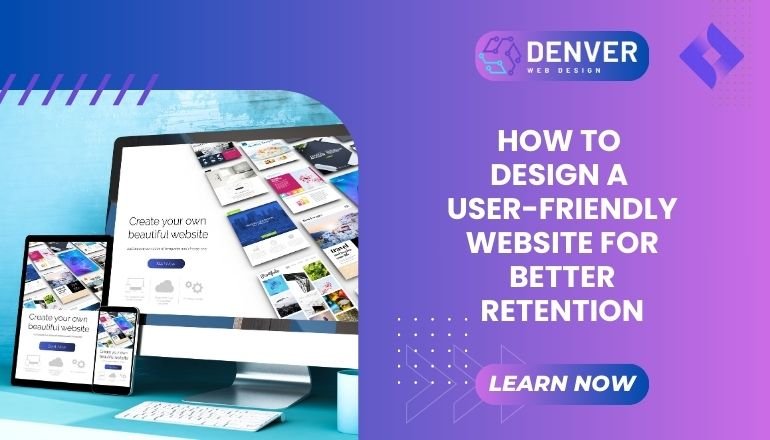
Creating a user-friendly website is essential for engaging visitors and encouraging them to return. A well-designed site enhances user experience (UX), reduces bounce rates, and increases conversions. In today’s competitive digital landscape, understanding best practices in web design and leveraging key components of responsive web design can make all the difference.
At Web Design Denver, we specialize in crafting websites that prioritize usability and retention, helping businesses build strong online connections with their audience.
What is a User-Friendly Website?
A user-friendly website is designed with the end-user in mind, prioritizing ease of navigation, accessibility, and responsiveness. It ensures that visitors can easily find information, complete actions, or engage with content regardless of their device or technical expertise. Key elements of a user-friendly website include:
- Intuitive Navigation: Logical menus and search functions.
- Responsive Design: Adapts seamlessly to different screen sizes.
- Fast Loading Speeds: Reduces waiting time for users.
- Clear Call-to-Actions (CTAs): Guides visitors to take desired actions.
By focusing on these features, businesses can create websites that are not only visually appealing but also functional and engaging.
Why is a User-Friendly Website Essential for Your Business?
- Enhances User Experience (UX)
A user-friendly website provides a smooth and enjoyable experience, encouraging visitors to stay longer and explore more. Good UX fosters trust and improves your brand’s credibility, which directly impacts conversion rate optimization (CRO).
- Improves SEO Performance
Search engines prioritize websites that deliver great user experiences. Fast loading speeds, responsive design, and organized content contribute to higher rankings, enhancing your site’s visibility on Google. Incorporating SEO for websites ensures better traffic and retention.
- Increases Retention and Loyalty
Visitors are more likely to return to websites that are easy to use and meet their needs. By addressing common pain points such as confusing navigation or slow performance, you create an environment where users feel comfortable engaging with your brand.
- Boosts Conversions
A user-friendly website guides users through a journey that leads to desired outcomes, such as making a purchase or signing up for a newsletter. Clear CTAs and an intuitive layout can significantly enhance conversion rate optimization (CRO).
Key Features of a User-Friendly Website
- Responsive Web Design
With the rise of mobile browsing, responsive design is critical. A website must adapt to various devices to provide a seamless experience for all users. - Clear Navigation
Visitors should be able to find what they’re looking for within seconds. Organize menus logically, and use breadcrumbs to guide users through your site. - Fast Load Times
Website loading speed is a major factor in user satisfaction. Tools like image optimization and caching can help achieve faster load times. - Accessible Design
Ensure your site is accessible to everyone, including those with disabilities. Use alt text for images, provide keyboard navigation options, and adhere to WCAG standards. - Engaging Content
High-quality, relevant content keeps users engaged. Incorporating visuals, videos, and infographics can enhance user interaction.
Best Practices for Designing a User-Friendly Website
- Focus on Mobile-First Design: Prioritize mobile responsiveness to cater to the growing number of mobile users.
- Simplify Navigation: Keep menus simple and intuitive, with a clear hierarchy.
- Use Visual Cues: Guide users with buttons, icons, and visual markers.
- Optimize Load Times: Use compressed images and clean code to ensure your site loads quickly.
- Test Usability: Regularly test your site on different devices and browsers to ensure a consistent experience.
Common Mistakes to Avoid
- Cluttered Design: Overloading your site with too much information or graphics can overwhelm users.
- Ignoring Accessibility: Neglecting accessibility features alienates a significant portion of your audience.
- Slow Loading Speeds: Sites that take too long to load drive users away.
- Lack of Clear CTAs: Confusing or missing calls-to-action result in lost opportunities for conversions.
- Outdated Content: Failing to update your website with fresh content can harm user engagement and SEO rankings.
Conclusion: Key Takeaways
A user-friendly website is a cornerstone of a successful online presence. By focusing on responsive design, fast load times, and intuitive navigation, businesses can enhance user experience, improve retention, and boost conversions. Avoid common pitfalls like cluttered layouts or slow speeds, and embrace best practices in web design to create a site that meets user expectations.
At Web Design Denver, we understand the importance of creating websites that are not only visually stunning but also functional and user-centric. Contact us today to learn how we can help design a website that keeps your visitors coming back!






